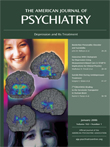Premenstrual Symptoms and Perimenopausal Depression
Abstract
OBJECTIVE: The role of ovarian steroids in both premenstrual dysphoria and perimenopausal depression has led to the suggestion that these conditions represent expressions of the same underlying disorder. Premenstrual mood symptoms were evaluated in women with perimenopause-related depression. METHOD: Self-reports and daily symptom ratings during one menstrual cycle were examined in 70 depressed perimenopausal women attending a menopause clinic and 35 nondepressed perimenopausal women. RESULTS: Twenty-six percent of the depressed and 9% of the nondepressed women reported premenstrual symptoms. Thirty-one percent of the depressed and 20% of the nondepressed women met criteria for significant menses-related symptom cyclicity (at least a 30% increase in the average ratings of at least two of four measured negative mood symptoms in the premenstrual versus the postmenstrual week); 5 of these depressed women and none of the comparison subjects described premenstrual symptoms on self-reports. Finally, 21% of the depressed and 3% of the nondepressed women met criteria for premenstrual dysphoria (symptom cyclicity and at least moderate severity, with symptoms exceeding a minimum luteal symptom severity threshold of 2.5). CONCLUSIONS: A higher-than-expected rate of menses-related symptom cyclicity and premenstrual dysphoria was observed in perimenopausal depressed women. However, neither menses-related symptom cyclicity nor premenstrual dysphoria was an invariant accompaniment of perimenopausal depression. Additionally, the rate of premenstrual dysphoria was not predicted by initial self-reports.



